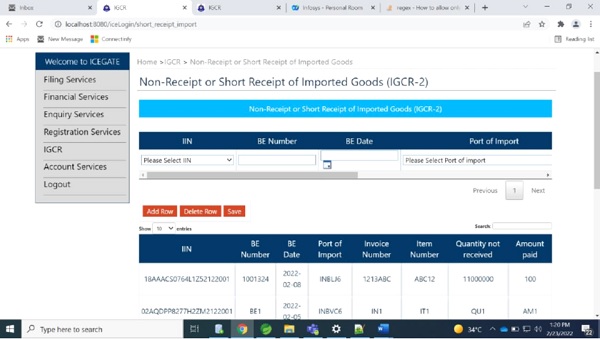Directorate General of Systems and Data Management
CENTRAL BOARD OF INDIRECT TAXES & CUSTOMS
Advisory No: 06/2022 | Date: 1st March, 2022
Category: Customs
Issued by: ICEGATE
Subject: Advisory for Importers to avail benefit of IGCR Rules (Import of Goods at Concessional Rate of duty)
IGCR module is developed by ICEGATE, CBIC to provide a digital service to importers to avail benefits under the IGCR Rules (Import of Goods at Concessional Rate of Duty).
The broad provisions are as under:
i. Available post log in on ICEGATE for importers in their existing account, registered with valid DSC.
ii. Provision of declaration of advance intimation of Import of Goods at concessional rate of duty.
iii. Generation of a unique IIN for a Financial Year with facility to amend as and when required.
iv. A continuity Bond of IGCR Bond Type is created or amended by the Importer.
v. Bond Management Module
vi. Multiple Details are auto populated in the monthly statement.
vii. Interface of details entered by the user provided to the jurisdictional Customs officer
2. This advisory is a complete step-by-step guide for the user to declare an advance intimation of goods to be imported, access continuity bond management module, file monthly return statements.
A. Access IGCR Module
Step 1. The user logs in ICEGATE portal with valid ICEGATE ID and password.
Step 2. Click on IGCR on the left panel to view the home screen of IGCR module as shown below. The user is given 4 options as follows.
a. Prior Intimation- Select this to declare the details of goods intended to be imported or manufactured, job workers (if any) and details of manufacturing unit of Importer or Job worker.
b. Bond Details/ Top up- Select this to request for a fresh continuity bond or top up the already created bond. Bond Balance is also displayed to the user.
c. Short Receipt- Select this to declare the short or non- receipt of any imported goods in the premises of Importer.
d. File Monthly Return- Select this to declare and submit the monthly return statement by the users.
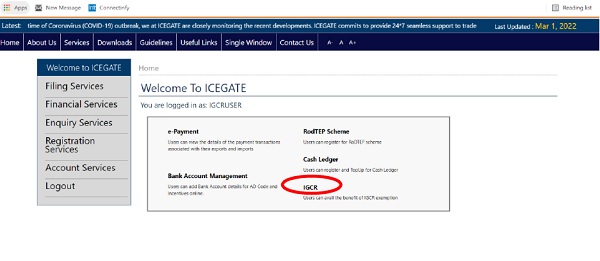
B. Submit Prior Intimation Request by Importer
Step 1: User can access the IGCR module as explained in Part A of the document. User can select Prior Intimation on the home screen of the module to submit an intimation of the intended import or view his previous intimations.
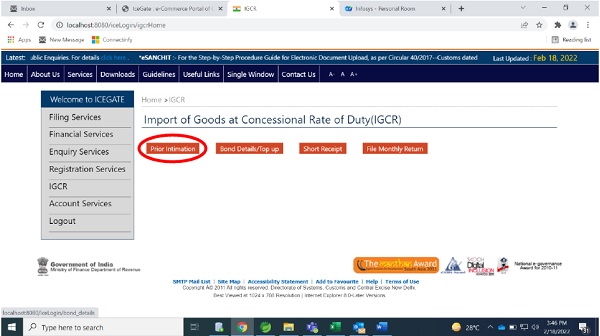
Step 2: A dashboard will be displayed to the user with all the previous IGCR Identification Numbers (IINs) created by him.
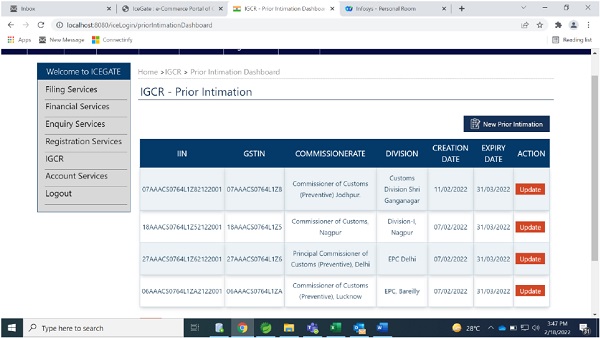
Step 3. User can click on “New Prior Intimation” on the right side as shown to declare the details of the new import to be done by the user.
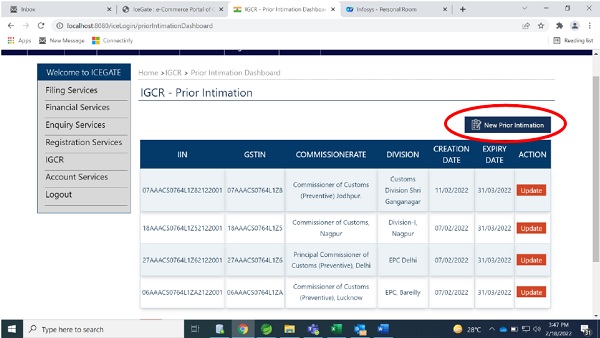
Step 4. Prior Intimation Request form with four tabs is displayed to the user.
a. Manufacturer Details – Details of the Importer
b. Goods to be Imported – Details of the goods intended to be imported
c. Goods to be manufactured – Details of the goods intended to be manufactured
d. Job Worker Details – Details of Job workers if any
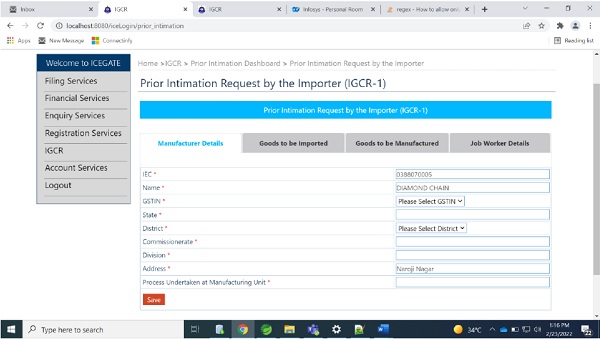
Step 5. User needs to enter the following details in the Manufacturer Details tab.
a. IEC – This will be entered by the system as per the login details
b. Name – This will be entered by the system as per the login details
c. GSTIN – User can select from the drop down of GSTINs available in the system
d. State – This will be entered by the system as per the GSTIN details
e. District – This will be entered by the system as per the GSTIN details
f. Commissionerate – This will be entered by the system as per the above details
g. Division – This will be entered by the system as per the above details
h. Address – Address of the premises of the Importer/manufacturer
i. Process undertaken at Manufacturing Unit of the Importer
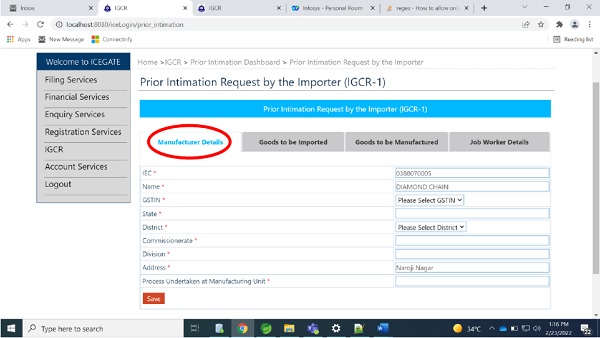
Step 6: User needs to enter the following information in the Goods to be imported tab. All these details will be corresponding to the goods intended to be imported by the importer.
a. CTH
b. Description of Goods
c. Quantity of Goods –
d. UQC
e. Value of Goods
f. Notification Number
g. Port of Import
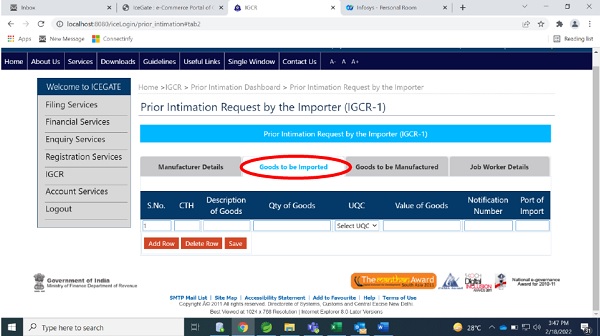
Step 7: User needs to enter the following information in Goods to be manufactured tab.
a. CTH – CTH of the Goods to be manufactured
b. Nature of goods produced
c. Notification Number
d. SAC Code – Service Accounting Code which is optional field and relevant only for the service providers.
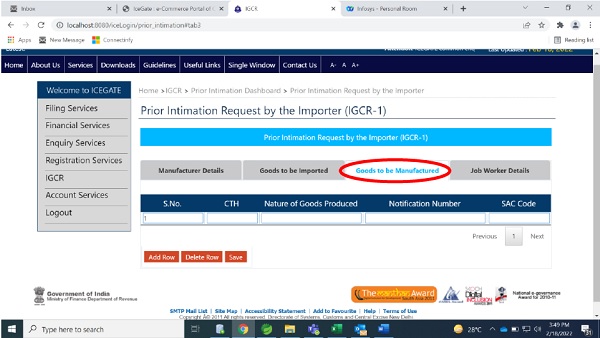
Step 8: User needs to provide the following details in the Job Worker details section.
a. Name
b. GSTIN
c. Address
d. Process undertaken at Unit of the Job Worker
e. Nature of Goods produced

C. BOND/ BG Details
User can access the IGCR module as explained in Part A of the document. User can select Bond/BG Details on the home screen of the module to submit a request for a fresh continuity bond or top up the existing continuity bond or view balance of the bond or provide BG details.
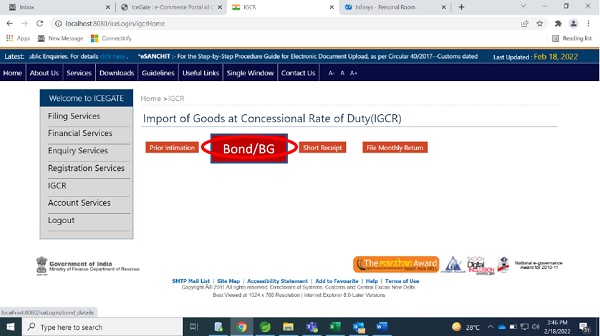
C.1 Create Fresh Continuity Bond
Step 1: User is required to fill the following information to create a new request for a fresh Continuity Bond.
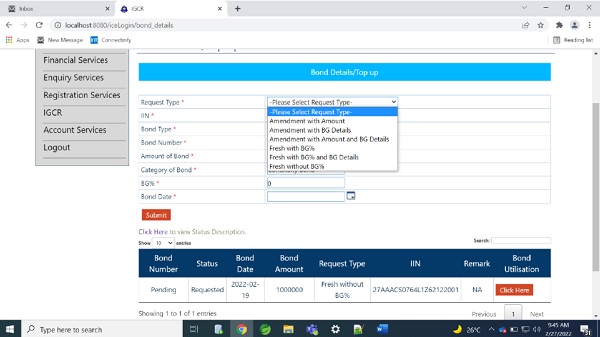
a. Request Type – User can select the following options.
a.1 Fresh without BG%- BG% field will be disabled for the user because the BG% is zero
a.2 Fresh with BG%- User can enter the BG%. This is used in case the user doesnot have BG details at the time of request submission. User can submit the BG details later on by selecting Amendment with BG details in the request type.
a.3 Fresh with BG% and BG details- User can enter the BG % in the field provided. Along with this, user will provide details of the Bank guarantee as provided below –
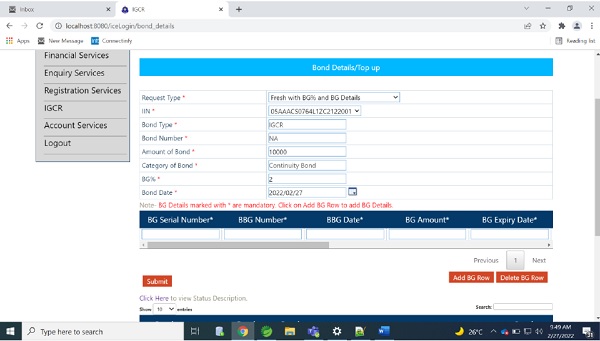
b. IIN – User to select the IGCR Identification Number (IIN) created after declaring prior Intimation request.
c. Bond Type – IGCR will be selected automatically
d. Bond Number – This will be NA in case of a fresh bond request
e. Amount of Bond – To be entered by the user
f. Category of Bond – Continuity Bond will be selected automatically
g. BG – Bank Guarantee percentage Involved
h. Bond Date – Current date can be entered by the user
C.2 Top Up/Amend Existing Continuity Bond
Step 1. User is required to fill details in the following fields to amend an existing bond.
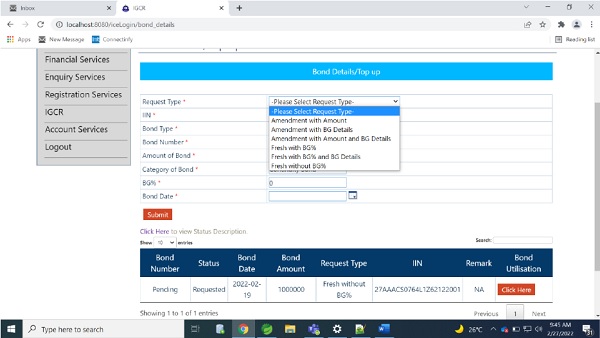
a. Request Type – User can select the following options.
a.1 Amendment with Amount- To be selected in case of Bond Top Up Requests.
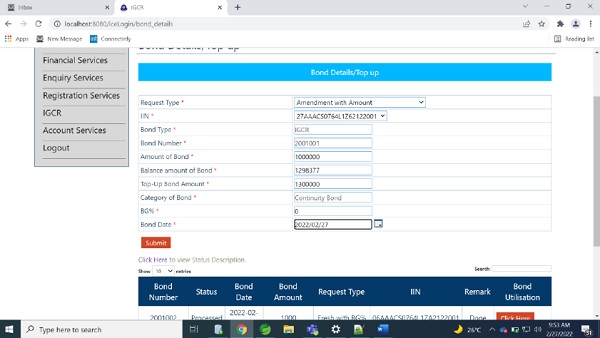
a.2 Amendment with BG details- To be selected in case of providing only BG details
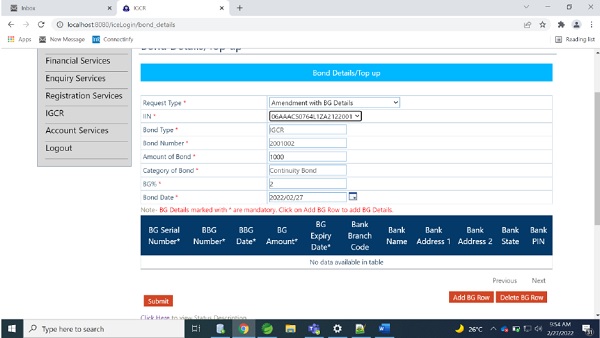
a.3 Amendment with Amount and BG Details- To be selected in case of Bond Top Up and providing BG details
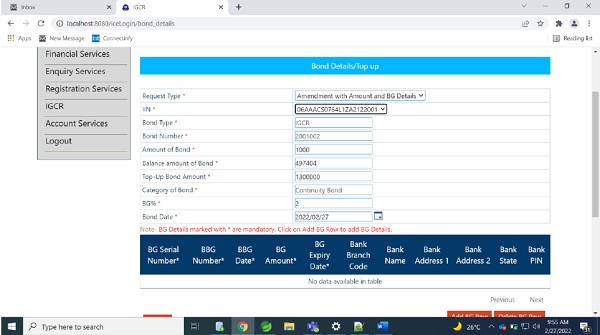
b. IIN – User to select the IGCR Identification Number (IIN) created after declaring prior Intimation request.
c. Bond Type – IGCR will be selected automatically
d. Bond Number – This will be pre-filled by system
e. Amount of Bond – The original amount of the bond when it was created
f. Balance amount of Bond – The balance of the bond after utilization

g. Top Up Bond Amount – The amount to be added to the balance amount of Bond. Please note that the top up bond amount cannot be less than amount of bond.
h. Category of bond – Continuity Bond will be selected automatically
i. BG – Bank Guarantee percentage involved
j. Bond Date – Current date can be selected by the user
Step 2: Subsequently, the physical copy of the bond and bank guarantee, wherever applicable will be submitted by the importer to the jurisdictional customs officer. The Bond format is shared in Annexure A and Adding BG/Bond Amendment format is shared in Annexure B of Circular No. 04/2022-Customs. https://www.cbic.gov.in/resources//htdocs-cbec/customs/cs-circulars/cs-circulars-2022/Circular-No-04-2022.pdf
Upon acceptance, the jurisdictional customs officer shall approve the bond request on the IGCR module at ICEGATE. The user can view the status of requests as explained in the next section.
C.3 View Bond Utilization Details
Users can view the status of the Bonds created or amended with BG details, wherever applicable in a dashboard available on the screen.
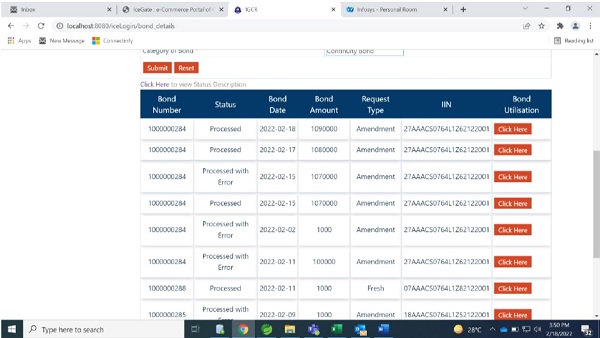
The explanation of the Bond Status is given as below.
a. Requested- New Request initiated by the user (Fresh or Amendment request)
b. Processed – Bond Request is processed by Customs and is pending with Customs Officer to Accept or Reject.
c. Processed with Error – Bond request is processed by Customs with an error. Error Descriptions are mentioned as below:
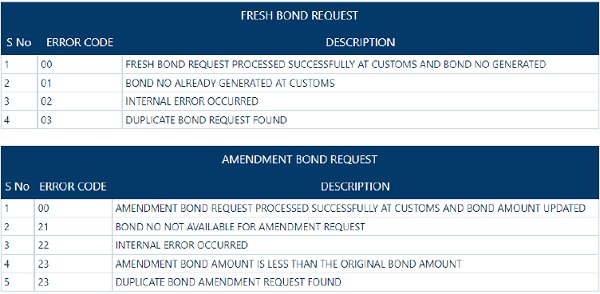
d. Accepted – Bond request is processed by Customs and accepted by Customs officer.
d. Rejected – Bond request is rejected by Customs Officer.
D. Monthly Return Statement
Step 1: User can access the IGCR module as explained in Part A of the document. User can select “File Monthly Return” on the home screen of the module to submit the utilization of the imported goods in a particular month.
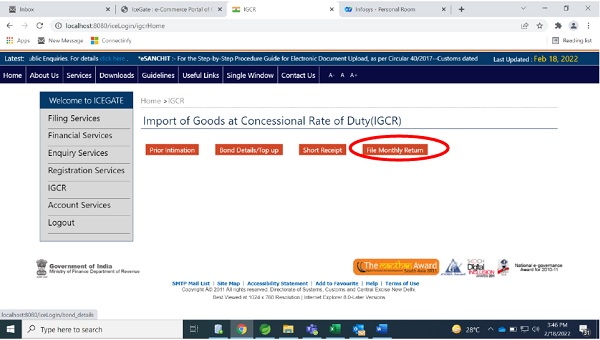
Step 2: User can select the Financial Year and Month and IIN for which the utilization details are to be submitted.
Please note that user needs to submit the return statement for a month latest by 10th of the following month. User cannot proceed to declare the utilization of a month without submitting the details of the previous month.
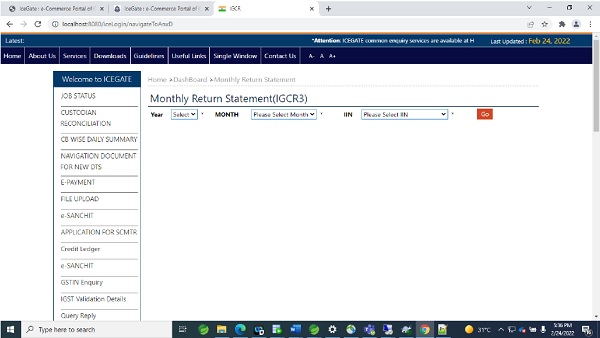
Step 3: User is required to provide information in the following four tabs.
a. Goods Imported: Details of goods actually imported by the importer
b. JW and Unit Transfer Details: Details of goods shared/received for/from job work
c. Re-export: Details of goods re-exported
d. Home Consumption: Details of goods cleared in domestic market after payment of duty
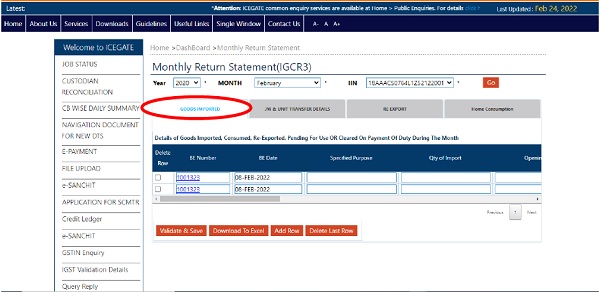
Step 4: User needs to enter the following information in the Goods Imported Tab.
a. BE Number – As per the details of the imported goods
b. BE Date – As per the details of the imported goods
c. Specified Purpose – As per the details of the imported goods
d. Quantity of Import – Quantity of goods actually imported
e. Opening Balance – Opening Balance of the quantity of goods for the month selected.
f. Date of clearance – Date of import
g. Value of Goods – In INR
h. Duty foregone – Amount of duty involved (BCD, Cess, Other Customs Duty, IGST)
i. Quantity Received – To be entered by the user
j. Date of receipt of Goods – Date of receipt of goods in the premises of the Importer
k. Quantity not received – Quantity of goods not received in the premises of the Importer. This should also be declared in IGCR 2 form, as explained in section E of the document.
l. Quantity used for Intended purpose – As per user
m. Goods Re exported – Quantity of goods to be re-exported. This should be declared in Step 6 of the section.
n. Goods cleared on payment of Duty – Quantity of goods cleared for Home Consumption. This should be declared in Step 7 of the section.
o. Quantity pending in stock at Importer’s premises – This will be added to the closing balance of the month.
p. Quantity pending in stock at job worker’s premises – This will be added to the closing balance of the month.
(Note- In case the BE details are not provided in the dashboard, user can manually enter the previous months’ BE details by clicking on Add Row)
Step 5. User needs to enter the following information in JW and unit transfer section.
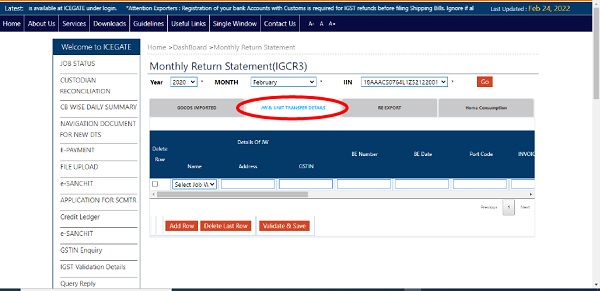
a. Details of Job Worker – Select name from the drop-down. List of Job workers’ names entered in the prior intimation is displayed for the user to select. Address and GSTIN are pre-populated as per the information provided in prior intimation.
b. BE Number – As per the details of the imported goods
c. BE Date – As per the details of the imported goods
d. port of Import – As per the details of the imported goods
e. Invoice Number – As per the details of the imported goods
f. Item Number – As per the details of the imported goods
g. Quantity sent for Job Work – Quantity involved to be entered by the user
h. Delivery challan/ e-way bill – Delivery details to be entered by the user
i. Date of sending the goods for Job work
j. Date of receipt of goods from Job Work – Must be within six months of sending the goods for job work
k. Quantity used for intended purpose and removed directly from the JW premises
l. Quantity used for intended purpose and received back at the importer’s premises
m. Quantity used for intermediate product and received back at importer’s premises
n. Quantity received at the importer’s premises from the JW without processing
(Note- The sum of quantity declared in k,l,m,n fields should sum up to Quantity of goods sent for Job work)
Step 6: User is required to enter the following information in re-export section
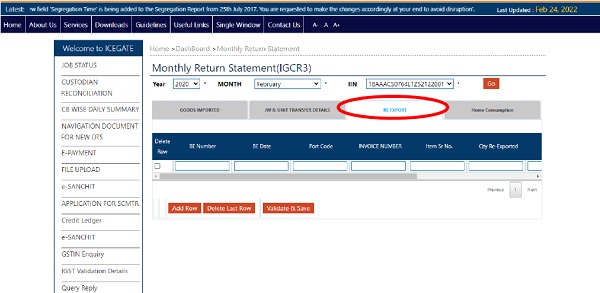
a. BE Number – As per the details of the imported goods
b. BE Date – As per the details of the imported goods
c. port of Import – As per the details of the imported goods
d. Invoice Number – As per the details of the imported goods
e. Item Number – As per the details of the imported goods
f. Quantity re-exported – Quantity of goods involved in Re-export
g. SB Number – As per the details of the corresponding export
h. SB Date – As per the details of the corresponding export
i. Port of Export – As per the details of the corresponding export
Step 7: User is required to enter the following information in Home Consumption section.
a. BE Number – As per the details of the imported goods
b. BE Date – As per the details of the imported goods
c. port of Import – As per the details of the imported goods
d. Invoice Number – As per the details of the imported goods
e. Item Number – As per the details of the imported goods
f. Quantity cleared – Quantity of goods involved in Home Consumption
g. Amount paid – Amount of duty paid for the goods involved
h. Capital goods cleared after depreciation – User can select Yes or No option
i. Date of Clearance – Date of clearance of goods for home consumption
j. Remarks – Any relevant information
E. Declare Short/non-Receipt of Imported goods (IGCR 2)
Step 1: User can access the IGCR module as explained in Part A of the document. User can select “Short Receipt” on the home screen of the module to submit the details of the imported goods which were not received in the importer’s premises.
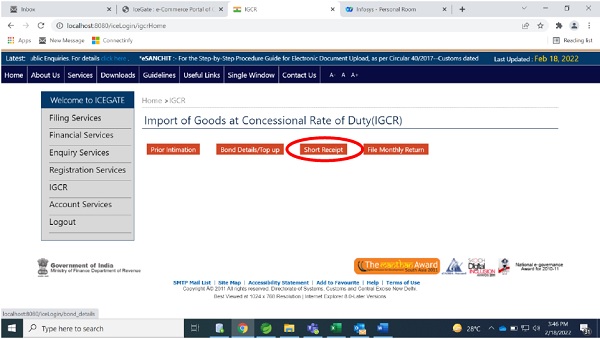
Step 2: In case the user has received less quantity of goods, user needs to fill this form with the following fields.
a. IIN – IGCR Identification Number created for the Import request.
b. BE Number – As per the Imported goods details
c. BE Date – As per the Imported goods details
d. Port of Import – As per the Imported goods details
e. Invoice Number – As per the Imported goods details
f. Item Number – As per the Imported goods details
g. Qty not received – Quantity of imported goods not received in premises
h. Amount paid – Amount of Duty paid for the quantity not received
